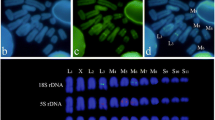Abstract
The molecular karyotype of the coccidial parasiteEimeria tenella has been further resolved. Different conditions of pulsed-field gel electrophoresis were used to separate up to 14 chromosomes that ranged in size between 1 and in excess of 6 megabase pairs (Mb) of DNA. Comparisons of several populations revealed some size polymorphisms of homologous chromosomes. Probes containing tandem repeats of the DNA sequence CAG and the telomeric-like sequence TTTAGGG hybridised to each chromosome. All other probes containing either repetitive or non-repetitive sequences were mapped to individual chromosomes.
Similar content being viewed by others
References
Canning EU, Anwar M (1968) Studies on meiotic division in coccidial and malarial parasites. J Protozool 15:290–298
Chapman HD, Rose ME (1986) Cloning ofEimeria tenella in the chicken. J Parasitol 72:605–606
Corcoran LM, Thompson JK, Walliker D, Kemp DJ (1988) Homologous recombination within subtelomeric repeat sequences generates chromosome size polymorphisms inPlasmodium falciparum. Cell 53:807–813
Cornelissen AWCA, Overdulve JP, Van der Ploeg M (1984) Determination of nuclear DNA of five eucoccidian parasites,Isospora (Toxoplasma) gondii, Sarcocystis cruzi, Eimeria tenella, E. acervulina and Plasmodium berghei, with special reference to gametogenesis and meiosis inI. (T.) gondii. Parasitology 88:521–553
Cowman AF, Lew AM (1990) Chromosomal rearrangements and point mutations in the DHFR-TS gene ofPlasmodium chabaudi under antifolate selection. Mol Biochem Parasitol 42:21–30
Fernando MA, Pasternak JJ (1991)Eimeria spp. of the domestic fowl: resolution of chromosomes by field inversion gel electrophoresis. Exp Parasitol 72:306–310
Foote SJ, Thompson JK, Cowman AF, Kemp DJ (1989) Amplification of the multi-drug resistance gene in some chloroquine resistant isolates ofPlasmodium falciparum. Cell 57:921–930
Kemp DJ, Thompson JK, Walliker D, Corcoran LM (1987) Molecular karyotype ofPlasmodium falciparum: conserved linkage groups and expendable histidine-rich protein genes. Proc Natl Acad Sci USA 84:7672–7676
Kim K, Gooze L, Petersen C, Gut J, Nelson RG (1992) Isolation, sequence and molecular karyotype analysis of the actin gene ofCryptosporidium parvum. Mol Biochem Parasitol 50:105–114
Ko C, Smith CK, McDonell M (1990) Identification and characterization of a target antigen of a monoclonal antibody directed againstEimeria tenella merozoites. Mol Biochem Parasitol 41:53–64
Liberator PA, Hsu J, Turner MJ (1989) Tandem trinucleotide repeats throughout the nucleotide sequence of a cDNA encoding anEimeria tenella sporozoite antigen. Nucleic Acids Res 17:7401
Long PL (1972)Eimeria tenella: reproduction, pathogenicity and immunogenicity of a strain maintained in chicken embryos by serial passage. J Comp Pathol 82:439–445
Mead JR, Arrowood MJ, Current WL, Sterling CR (1988) Field inversion gel electrophoretic separation ofCryptosporidium spp. chromosome-sized DNA. J Parasitol 74:366–369
Mencher D, Sar-Shalom O, Pillimer G, Halabi A, Wallach M (1989)Eimeria maxima sexual stage antigens: cloning and expression of a high molecular weight gametocyte antigen. In: Yvore P (ed) Coccidia and intestinal coccidiomorphs. Proceedings of the Vth International Coccidiosis Conference, Tours, France. INRA, Paris, pp 605–608
McDonald VM, Shirley MW, Millard BJ (1986) A comparative study of two lines ofEimeria tenella attenuated either by selection for precocious development in the chicken or by growth in chicken embryos. Avian Pathol 15:323–335
McDougald LR, Jeffers TK (1976)Eimeria tenella (Sporozoa, Coccidia): gametogony following a single asexual generation. Science 192:258–259
Morzaria SP, Spooner PR, Bishop RP, Musoke AJ, Young JR (1990) SfiI and NotI polymorphisms inTheileria stocks detected by pulsed field gel electrophoresis. Mol Biochem Parasitol 40:203–212
Pologe LG, Ravetch JV (1988) Large deletions result from breakage and healing ofPlasmodium falciparum chromosomes. Cell 55:869–874
Ponzi M, Pace T, Dore E, Frontali C (1985) Identification of a telomeric DNA sequence inPlasmodium berghei. EMBO J 4:2991–2995
Richards EJ, Ausubel FM (1988) Isolation of a higher eucaryotic telomere fromArabidopsis thaliana. Cell 53:127–136
Saiki RK, Scharf S, Faloona F, Mullis KB, Horn GT, Erlich HA, Arnheim N (1985) Enzymatic amplification of B-globin genomic sequences and restriction site analysis for diagnosis of sickle cell anaemia. Science 230:1350–1354
Sambrook J, Fritsch EF, Maniatis T (1989) Molecular cloning. A laboratory manual. Cold Spring Harbor Laboratory Press, Cold Spring Harbor, New York
Schmatz DM, Crane St J, Murray PK (1984) Purification ofEimeria sporozoites by DE-52 anion exchange chromatography. J Protozool 31:181–183
Scholtyseck E (1963) Untersuchungen über die Kernverhältnisse und das Wachstum bei Coccidiomorphen unter besonderer Berücksichtigung vonEimeria maxima. Z Parasitenkd 22:428–474
Shirley MW (1975) Enzyme variation inEimeria species of the chicken. Parasitology 71:369–376
Shirley MW (1994) Coccidial parasites from the chicken: discrimination of different populations ofEimeria tenella by DNA hybridisation. Res Vet Sci (in press)
Shirley MW, Millard BJ (1976) Some observations on the sexual differentiation ofEimeria tenella using single sporozoite infections in chicken embryos. Parasitology 73:337–341
Shirley MW, Kemp DJ, Pallister J, Prowse SJ (1990) A molecular karyotype ofEimeria tenella as revealed by contour-clamped homogenous electric field gel electrophoresis. Mol Biochem Parasitol 38:169–174
Sibley LD, Boothroyd JC (1992) Construction of a molecular karyotype forToxoplasma gondii. Mol Biochem Parasitol 51:291–300
Sibley LD, LeBlanc AJ, Pfefferkorn ER, Boothroyd JC (1992) Generation of a restriction fragment length polymorphism linkage map forToxoplasma gondii. Genetics 132:1003–1015
Stucki U, Braun R, Roditi I (1993)Eimeria tenella: characterization of a 5s ribosomal RNA repeat unit and its use as a species-specific probe. Exp Parasitol 76:68–75
Su H-Y, Tenter AM, Johnson AM (1992) Genomic analysis ofSarcocystis by contour-clamped homogeneous electric fields. J Protozool Res 2:16–24
Author information
Authors and Affiliations
Rights and permissions
About this article
Cite this article
Shirley, M.W. The genome ofEimeria tenella: Further studies on its molecular organisation. Parasitol Res 80, 366–373 (1994). https://doi.org/10.1007/BF00932373
Received:
Accepted:
Issue Date:
DOI: https://doi.org/10.1007/BF00932373




